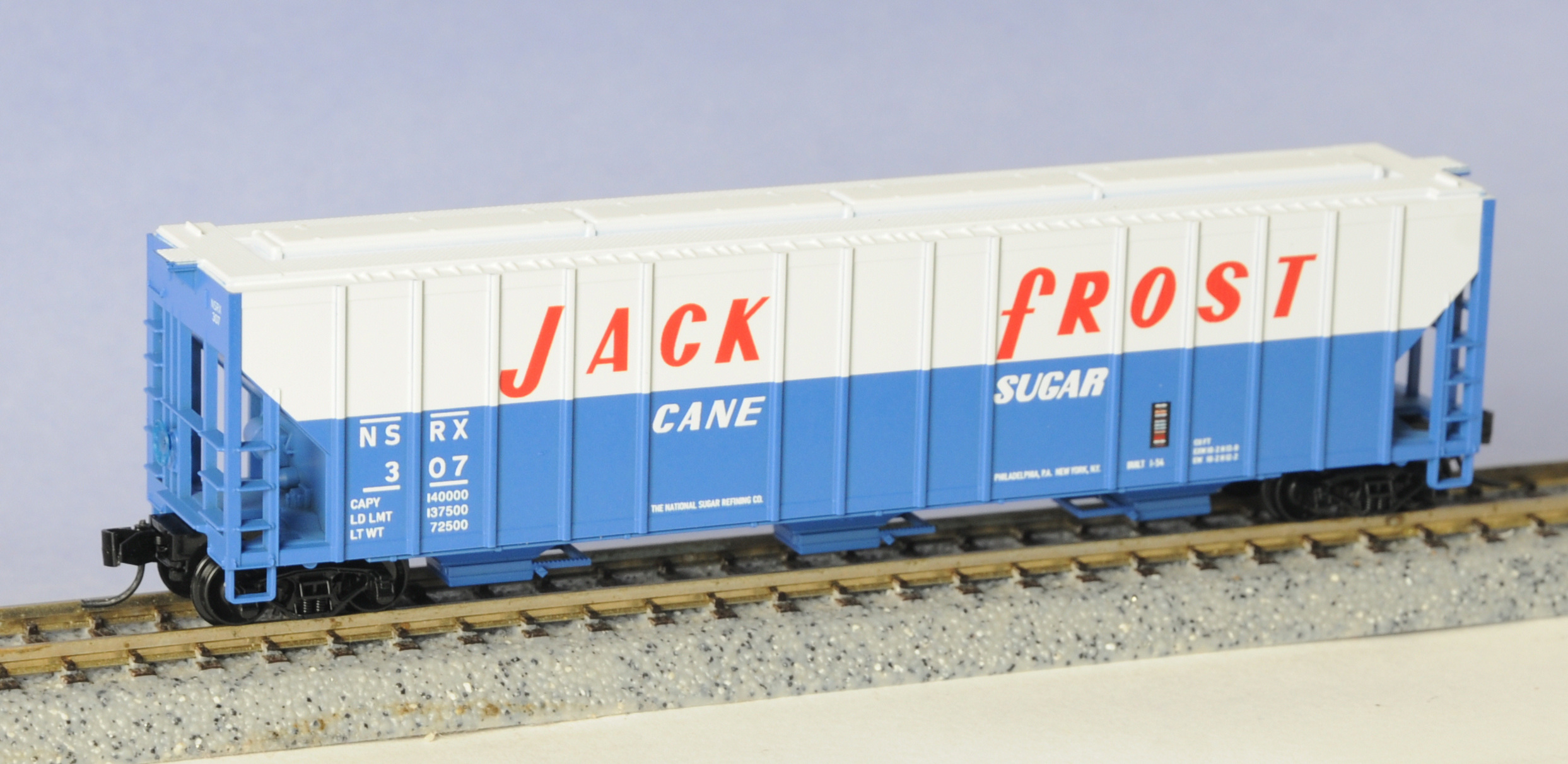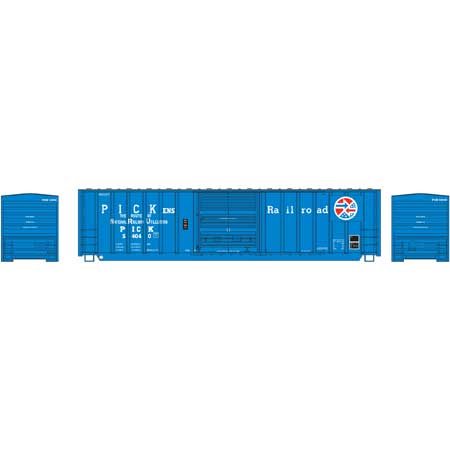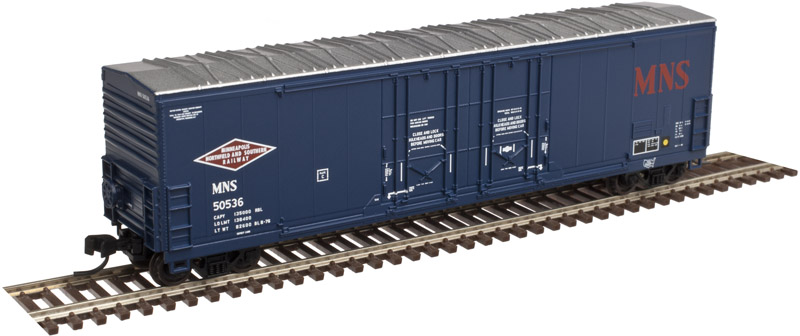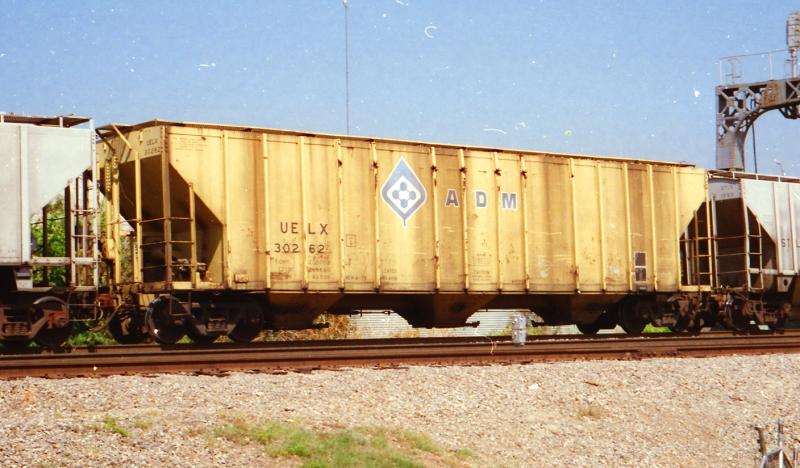Specific Item Information: This 3-bay covered hopper is blue with white band and red herald and runs on Bettendorf trucks. Built in 1954, this 2,893 cubic-foot three-bay hopper was part of a 10-car series lettered for The National Sugar Refining Company in the “Jack Frost Cane Sugar” scheme. These cars were primarily seen on the east coast, travelling between sugar refining plants, bakeries and confectionary manufacturers from the 1950s to the 1960s.
Model Information: Micro-Trains first released this model in 2006. It is a model of the Evans three bay covered hopper which was first built in 1966. This tooling has been used to model both Evans 4750 and 4780 prototypes.
Prototype History: Distinguished by its unique Youngstown corrugated roof, the Evans 4780 Covered Hopper is a common prototype with uncommon features. Beginning with the first production order in December of 1976, Evans produced over 4,000 hoppers during the five-year production period. Popular among Nebraska cooperatives and lessees, the Evans 4780 has plied the rails everywhere in North America. Since the late 1970s the 55' Evans 4780 Covered Hopper has been a grain-hauling favorite.
Road Name History: 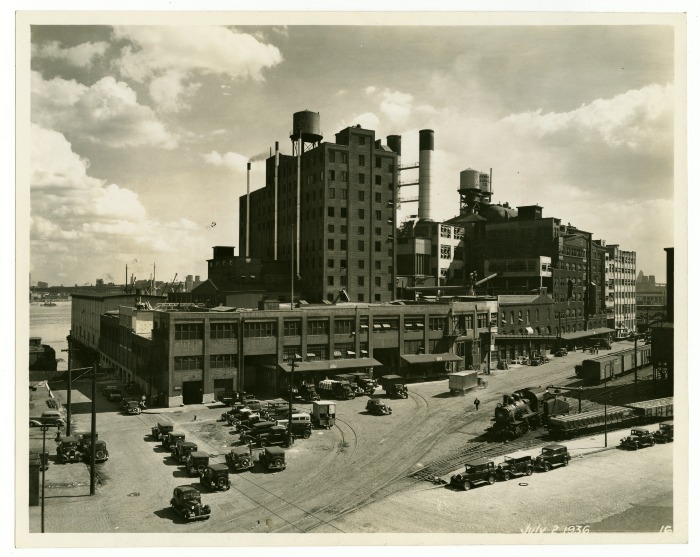 In 1900 Henry O. Havemeyer eliminated the little remaining competition to American Sugar (Domino) in the greater New York City region by consolidating the major competitive refineries in the city into the National Sugar Refining Company of New Jersey. The National Sugar Refining Co. (NSRC) was established by the consolidation of the Mollenhauer, National and New York refineries. It controlled 13 sugar mills in Cuba under a series of different corporate names and reorganized several times, making following its interests somewhat complicated.
In 1900 Henry O. Havemeyer eliminated the little remaining competition to American Sugar (Domino) in the greater New York City region by consolidating the major competitive refineries in the city into the National Sugar Refining Company of New Jersey. The National Sugar Refining Co. (NSRC) was established by the consolidation of the Mollenhauer, National and New York refineries. It controlled 13 sugar mills in Cuba under a series of different corporate names and reorganized several times, making following its interests somewhat complicated.
In May 1920 the NSRC began an expansion program with the establishment of the Cuba-Santo Domingo Sugar Development Syndicate. Although it is likely there was a relationship between the NSRC and the American Sugar Refining Co., it was never clearly stated. The Louisiana Planter and Sugar Manufacturer edition of December 20, 1924 states that negotiations were completed the week prior for the purchase of the NSRC by the American Sugar Refining Co. (Domino Sugar) at a cost of $16.5 million in cash.
Up until the end of 1947, Quaker Sugar was a brand of the Philadelphia Sugar Company. Starting in 1948, it was manufactured by the Pennsylvania Sugar Division of the NSRC, itself a division of Domino. Known to many in the neighborhood as the Sugar House, this long-standing sugar refinery closed its doors in 1984. The Pennsylvania Sugar Refining Company was the last independent producer to fight the giant Sugar Trust early in the 20th century; it later became the Pennsylvania Division of the National Sugar Refining Company in 1942.

In May 1920 the NSRC began an expansion program with the establishment of the Cuba-Santo Domingo Sugar Development Syndicate. Although it is likely there was a relationship between the NSRC and the American Sugar Refining Co., it was never clearly stated. The Louisiana Planter and Sugar Manufacturer edition of December 20, 1924 states that negotiations were completed the week prior for the purchase of the NSRC by the American Sugar Refining Co. (Domino Sugar) at a cost of $16.5 million in cash.
Up until the end of 1947, Quaker Sugar was a brand of the Philadelphia Sugar Company. Starting in 1948, it was manufactured by the Pennsylvania Sugar Division of the NSRC, itself a division of Domino. Known to many in the neighborhood as the Sugar House, this long-standing sugar refinery closed its doors in 1984. The Pennsylvania Sugar Refining Company was the last independent producer to fight the giant Sugar Trust early in the 20th century; it later became the Pennsylvania Division of the National Sugar Refining Company in 1942.
Brand/Importer Information: Micro-Trains is the brand name used by both Kadee Quality Products and Micro-Trains Line. For a history of the relationship between the brand and the two companies, please consult our Micro-Trains Collector's Guide.
Manufacturer Information:  Micro-Trains Line split off from Kadee Quality Products in 1990. Kadee Quality Products originally got involved in N-Scale by producing a scaled-down version of their successful HO Magne-Matic knuckle coupler system. This coupler was superior to the ubiquitous 'Rapido' style coupler due to two primary factors: superior realistic appearance and the ability to automatically uncouple when stopped over a magnet embedded in a section of track. The success of these couplers in N-Scale quickly translated to the production of trucks, wheels and in 1972 a release of ready-to-run box cars.
Micro-Trains Line split off from Kadee Quality Products in 1990. Kadee Quality Products originally got involved in N-Scale by producing a scaled-down version of their successful HO Magne-Matic knuckle coupler system. This coupler was superior to the ubiquitous 'Rapido' style coupler due to two primary factors: superior realistic appearance and the ability to automatically uncouple when stopped over a magnet embedded in a section of track. The success of these couplers in N-Scale quickly translated to the production of trucks, wheels and in 1972 a release of ready-to-run box cars.
Micro-Trains Line Co. split off from Kadee in 1990 to form a completely independent company. For this reason, products from this company can appear with labels from both enterprises. Due to the nature of production idiosyncrasies and various random factors, the rolling stock from Micro-Trains can have all sorts of interesting variations in both their packaging as well as the products themselves. When acquiring an MTL product it is very important to understand these important production variations that can greatly enhance (or decrease) the value of your purchase.
Please consult our Micro-Trains Collector's Guide

Micro-Trains Line Co. split off from Kadee in 1990 to form a completely independent company. For this reason, products from this company can appear with labels from both enterprises. Due to the nature of production idiosyncrasies and various random factors, the rolling stock from Micro-Trains can have all sorts of interesting variations in both their packaging as well as the products themselves. When acquiring an MTL product it is very important to understand these important production variations that can greatly enhance (or decrease) the value of your purchase.
Please consult our Micro-Trains Collector's Guide
Item created by: CMK on 2021-01-30 03:37:47. Last edited by gdm on 2021-02-25 14:13:00
If you see errors or missing data in this entry, please feel free to log in and edit it. Anyone with a Gmail account can log in instantly.
If you see errors or missing data in this entry, please feel free to log in and edit it. Anyone with a Gmail account can log in instantly.


